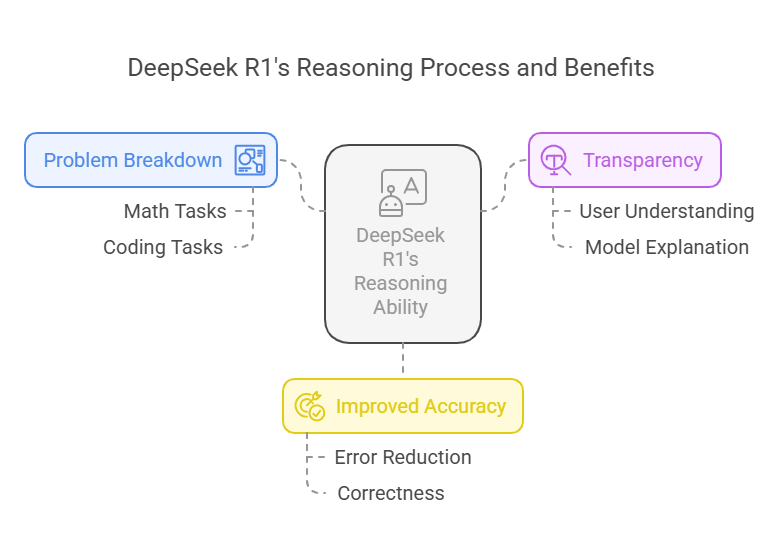DeepSeek API Overview: Your Introduction and Key Benefits
Explore the fundamentals of DeepSeek API, including its key features, practical use cases, and how to start seamlessly integrating it into your workflow.

Why Choose DeepSeek API?
Key Advantages Over Alternate APIs
DeepSeek API stands apart due to its blend of scalability, customization, and ease of use. Here are some of its standout advantages:
- AI-Powered Insights: Unlike many traditional APIs, DeepSeek API leverages advanced AI to provide predictive analytics and trend forecasting.
- Cross-Platform Compatibility: It supports integration with popular frameworks and languages like Python, JavaScript, and Java.
- Speed and Reliability: Its optimized architecture ensures low-latency responses, even during peak usage.
- Robust Documentation: Developers benefit from detailed guides, tutorials, and live support, reducing onboarding times significantly.
- Scalability: With features like load balancing and clustering support, it scales effortlessly to handle growing traffic and large datasets.
For more on endpoints and integration, see DeepSeek API Endpoints.
Ideal Target Audience
Businesses and developers across diverse industries can leverage DeepSeek API. However, it is particularly beneficial for:
- E-Commerce: For implementing personalized product recommendations and dynamic search functionalities.
- Healthcare Firms: To process large volumes of patient data and perform critical analysis in real time.
- Tech Startups: Startups looking to rapidly prototype and deploy data-driven applications without building backend data pipelines from scratch.
Key Features of DeepSeek API
Core Functionalities Explained
DeepSeek API offers a rich set of features tailored to meet diverse developer needs:
- Advanced Search Capabilities: Perform faceted search queries, fuzzy matching, and advanced filtering for both structured and unstructured data.
- Example: An e-commerce application can use DeepSeek API to allow users to search for products based on price ranges, brands, and availability.
- Data Aggregation: Combine and process data from multiple sources into a unified, consumable format.
- Example: Merging customer reviews from different platforms into a single analytics dashboard.
- Real-Time Analytics: Monitor behaviors and trends for web applications in real time.
- Example: Real-time tracking of customer activity on an app to refine user experiences.
- AI-Powered Recommendations: Generate predictive insights into user preferences or market behavior.
Scalability and Performance Benefits
Scalability and performance are at the core of DeepSeek API's architecture:
- Horizontal Scalability: Designed to handle increased traffic by distributing workloads across multiple servers.
- Caching: Built-in caching mechanisms significantly reduce query response times.
- High Availability: Ensures continuous uptime through failover clustering and redundancy mechanisms.
Real-World Example
A travel booking platform used DeepSeek API to analyze millions of user interactions daily and provide tailored recommendations. The integration reduced backend processing times by 40%, effectively cutting costs and boosting customer satisfaction.
Practical Use Cases of DeepSeek API
Applications Across Industries
DeepSeek API is a versatile tool with applications in:
- Retail: Personalized product suggestions, inventory management, and customer behavior analysis.
- Finance: Fraud detection, real-time transaction analysis, and regulatory compliance.
- Healthcare: Aggregating patient records to power machine learning models for predictive diagnoses.
- Marketing: Campaign performance tracking and audience segmentation.
For a comparison of free and paid plans, check DeepSeek API Free Tiers.
Use Case Spotlight: Retail
An online retailer leveraged DeepSeek API to create dynamic filtering options for their product catalog. This integration resulted in a 15% increase in user engagement as shoppers found products faster and more intuitively.
Streamlining Workflows with DeepSeek API
DeepSeek API excels at automating workflows:
- Automating repetitive data processing tasks like ETL (Extract, Transform, Load) pipelines.
- Centralizing disparate data sources into a single endpoint for simplified access.
- Reducing manual error-prone interventions with structured job scheduling.
Example: Automation
A logistics company integrated the API to consolidate data from vehicle tracking systems, weather sources, and delivery updates. This reduced delivery delays by 30%, improving overall logistics efficiency.
How to Get Started with DeepSeek API
Setting Up Your Integration
To integrate DeepSeek API, follow this simple step-by-step guide:
- Sign Up: Create an account on the DeepSeek platform and retrieve your API key.
- Set Up Authentication: Implement API key-based authentication or OAuth 2.0 in your application.
- Test Endpoints: Use tools like Postman or cURL to test API responses and parameters.
- Embed in Your Application: Integrate the desired endpoints into your application using a language-specific SDK or HTTP requests.
System Prerequisites
- Minimum requirements:
- Languages Supported: Python 3.x, Java 8 and above, JavaScript (Node.js).
- Supported Protocols: HTTPS, JSON for request and response formats.
- Infrastructure: A system with modern CPU architecture and at least 8 GB RAM.
Essential API Documentation Overview
DeepSeek provides comprehensive documentation with:
- Endpoint References: Detailed explanation of endpoints and query parameters.
- Code Examples: Sample implementations in multiple programming languages.
- Error Handling Guide: Common error codes and troubleshooting tips.
- Library Index: A quick-access list of all SDK features.
Best Practices for Using DeepSeek API
Optimizing API Performance
To maximize performance:
- Use batch requests to reduce the number of API calls.
- Implement rate limiting where necessary to avoid throttling.
- Enable caching for frequently accessed data.
If you need troubleshooting tips, see DeepSeek API Troubleshooting Roadblocks.
Maintaining Security and Compliance
DeepSeek API offers several features to ensure safe usage:
- Encrypt Data in Transit: Always use HTTPS for API calls to protect data from interception.
- Access Control Best Practices: Keep API keys secret and use role-based permissions for better security control.
- Compliance Standards: Verify configurations to meet GDPR, HIPAA, or other regulatory standards depending on your industry.
By implementing these best practices and utilizing its robust set of features, DeepSeek API can be a game-changer for developers and businesses looking to streamline data workflows and extract maximum value from their raw data.